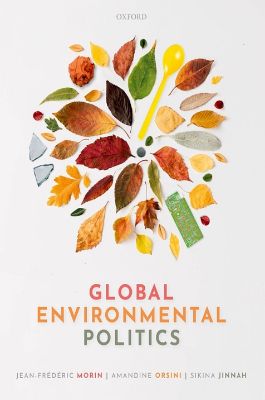Global Environmental Politics

Lýsing:
Global Environmental Politics provides a fully up to date and comprehensive introduction to the most important issues dominating this fast moving field. Going beyond the issue of climate change, the textbook also introduces students to the pressing issues of desertification, trade in hazardous waste, biodiversity protection, whaling, acid rain, ozone-depletion, water consumption, and over-fishing.
. Importantly, the authors pay particular attention to the interactions between environmental politics and other governance issues, such as gender, trade, development, health, agriculture, and security. Adopting an analytical approach, the authors explore and evaluate a wide variety of political perspectives, testing students' assumptions and equipping them with the necessary tools to develop their own arguments and, ultimately, inspiring students to pursue their own research endeavours in this diverse field.
Annað
- Höfundar: Jean-Frédéric Morin, Amandine Orsini, Sikina Jinnah
- Útgáfudagur: 2020-03-31
- Hægt að prenta út 2 bls.
- Hægt að afrita 2 bls.
- Format:ePub
- ISBN 13: 9780192560780
- Print ISBN: 9780198826088
- ISBN 10: 0192560786
Efnisyfirlit
- Cover
- Title page
- Copyright
- Acknowledgements
- How to use the online resources
- Contents
- List of figures
- List of tables
- List of boxes
- List of acronyms and abbreviations
- Introduction
- 0.1 Key issues in global environmental politics
- 0.2 The emergence of global environmental action
- 0.3 Global environmental politics as a field of study
- 0.4 How to use this book
- Annex 0.1: Key multilateral environmental agreements: Obligations and political context
- Part 1: Defining global environmental issues
- 1 Interconnections between science and politics
- 1.1 Cooperation under scientific uncertainty
- 1.2 Experts as political actors
- 1.3 The co-production of science and politics
- 1.4 The interface of science and politics
- 1.5 Conclusion
- 2 Ideas about environmental protection
- 2.1 Are there universal environmental values?
- 2.2 Does the environment have an intrinsic value?
- 2.3 Does human intervention cause more harm than good?
- 2.4 Does economic growth help or harm environmental protection?
- 2.5 Intragenerational versus intergenerational equity
- 2.6 Conclusion
- 1 Interconnections between science and politics
- 3 States
- 3.1 Domestic sources of state preferences
- 3.2 International sources of state preferences
- 3.3 Conclusion
- 4 Non-state actors
- 4.1 NGOs in global environmental governance
- 4.2 Business engagement in global environmental governance
- 4.3 Non-state actor influence
- 4.4 Transnational governance
- 4.5 Conclusion
- 5 The tragedy of the commons and sovereign rights
- 5.1 The tragedy of the commons
- 5.2 The common heritage of humankind
- 5.3 Sovereignty over natural resources
- 5.4 Conclusion
- 6 Development and the environment: From the Stockholm Summit to the Sustainable Development Goals
- 6.1 Three views on environment and development
- 6.2 Stockholm, 1972: an initial compromise between systemic and structural views
- 6.3 The Brundtland Report, 1987: the birth of sustainable development
- 6.4 Rio, 1992: the rise of the liberal view
- 6.5 Johannesburg, 2002: dilution of the systemic view
- 6.6 Rio+20, 2012: towards a new equilibrium?
- 6.7 Conclusion
- 7 International institutions
- 7.1 The birth of environmental concerns in international institutions
- 7.2 The autonomy of international institutions
- 7.3 Interactions between international institutions
- 7.4 Designing global environmental governance
- 7.5 Conclusion
- 8 Policy instruments and effectiveness
- 8.1 The effectiveness of global environmental politics
- 8.2 Types of policy instruments
- 8.3 The diffusion of instruments
- 8.4 What are the political effects of instruments?
- 8.5 Conclusion
- 9 Natural resources, security, and conflicts
- 9.1 The ambiguous concept of environmental security
- 9.2 Environmental degradation as a trigger for armed conflict
- 9.3 Human and environmental security
- 9.4 Environmental impact of security policies
- 9.5 Conclusion
- 10 Trade and the environment
- 10.1 Is trade good or bad for the environment?
- 10.2 Trade dimensions of environmental regimes
- 10.3 Environmental dimensions of the global trade regime
- 10.4 Conclusion
UM RAFBÆKUR Á HEIMKAUP.IS
Bókahillan þín er þitt svæði og þar eru bækurnar þínar geymdar. Þú kemst í bókahilluna þína hvar og hvenær sem er í tölvu eða snjalltæki. Einfalt og þægilegt!Rafbók til eignar
Rafbók til eignar þarf að hlaða niður á þau tæki sem þú vilt nota innan eins árs frá því bókin er keypt.
Þú kemst í bækurnar hvar sem er
Þú getur nálgast allar raf(skóla)bækurnar þínar á einu augabragði, hvar og hvenær sem er í bókahillunni þinni. Engin taska, enginn kyndill og ekkert vesen (hvað þá yfirvigt).
Auðvelt að fletta og leita
Þú getur flakkað milli síðna og kafla eins og þér hentar best og farið beint í ákveðna kafla úr efnisyfirlitinu. Í leitinni finnur þú orð, kafla eða síður í einum smelli.
Glósur og yfirstrikanir
Þú getur auðkennt textabrot með mismunandi litum og skrifað glósur að vild í rafbókina. Þú getur jafnvel séð glósur og yfirstrikanir hjá bekkjarsystkinum og kennara ef þeir leyfa það. Allt á einum stað.
Hvað viltu sjá? / Þú ræður hvernig síðan lítur út
Þú lagar síðuna að þínum þörfum. Stækkaðu eða minnkaðu myndir og texta með multi-level zoom til að sjá síðuna eins og þér hentar best í þínu námi.
Fleiri góðir kostir
- Þú getur prentað síður úr bókinni (innan þeirra marka sem útgefandinn setur)
- Möguleiki á tengingu við annað stafrænt og gagnvirkt efni, svo sem myndbönd eða spurningar úr efninu
- Auðvelt að afrita og líma efni/texta fyrir t.d. heimaverkefni eða ritgerðir
- Styður tækni sem hjálpar nemendum með sjón- eða heyrnarskerðingu
- Gerð : 208
- Höfundur : 17808
- Útgáfuár : 2020
- Leyfi : 380


